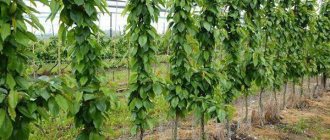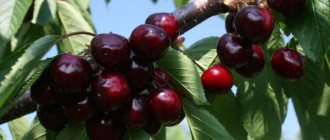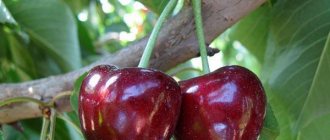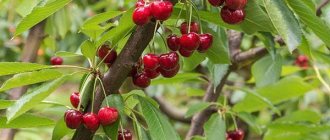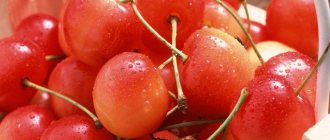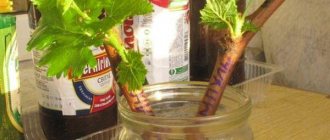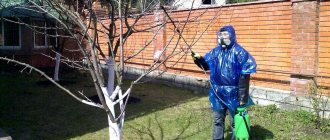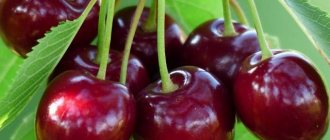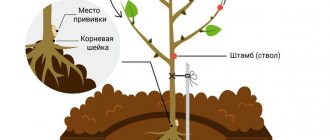Photo and description of the cherry variety Valery Chkalov
The authors of the variety are M.T. Oratovsky and S.V. Zhukov. Cherry was the result of joint work of two scientific institutions in Michurinsk and Melitopol. The parent variety is Caucasian Pink. In 1974, this cherry was included in the state register and recommended for planting in the North Caucasus.
Mature tree height
The tree is tall and large, reaching 5 m. An adult cherry tree has a spreading crown with a large number of leaves. The conductor is thickened, the crown is rough, grayish-brown in color. Skeletal shoots grow at an acute angle and are red-brown in color. The remaining branches are brown-gray, strongly curved, and reach 5 mm in diameter. Cone-shaped buds. The leaves are 10x19 cm in size, oval in shape, with jagged edges. Petioles 50 mm long with two pronounced glands at the base of the leaf. How Valery Chkalov’s cherry grows and bears fruit can be found in the video:
Flowering and ripening period
The variety is early ripening. Flowers bloom at the end of April, the first fruits appear at the beginning of June. The cherry is large, weighing from 6 to 8 g, broad-heart-shaped. The fruits are rich burgundy in color, some specimens are almost black. The juice is dark red, the flesh is slightly gristly, with pink veins, and contains a lot of juice. The stone is large, light brown, round. The stalk is 4 cm long. The fruits are held firmly, and when they are removed, juice is released.
Productivity
The variety shows high productivity. The first fruits ripen in the 5th year of life. Peak fruiting occurs at 12 years of age. The maximum yield is 174 kg of fruit from each cherry. In Crimea, the yield of the variety is about 60 kg, in Krasnodar – 30 kg. The fruiting period is 20 years.
Transportability
Due to the dense pulp, the fruits tolerate transportation well. Due to its good taste, the variety has a dessert purpose and is suitable for home canning.
Drought resistance
Sweet cherries prefer moderate watering. The variety Valery Chkalov is no exception. To obtain a good harvest, it is moistened according to the standard scheme.
Frost resistance
Frost resistance is average. When the temperature drops to -24 °C, up to 70% of flower buds die. To increase cold resistance in the fall, the variety is prepared for winter.
Diseases and pests
Although this variety is susceptible to fungal diseases, timely prevention will help avoid them.
Recent Entries
Lilac perennials that are beautiful, compact and do not crowd out other plants Why when buying seedlings you should not take the sellers’ word for it and how to determine the age of the plant using 3 signs Tomato seedlings have turned purple or whitish: why the color has changed and how to save the plants
Table: disease and pest prevention measures for cherries Valery Chkalov
| Deadlines | Events | Methods of execution | Achieved effect |
| Autumn | Collection and removal of fallen leaves | Fallen leaves are raked into a pile, weeds, dry branches, etc. are also placed there. The pile is burned, and the resulting ash is stored for later use as fertilizer. | Destruction of spores of fungal pathogens and wintering pests in foliage |
| Examination and treatment (if necessary) of the cortex | If the inspection reveals cracks, damage, or wounds, they should be cleaned and cut down to healthy bark and wood. After this, you need to treat it with a 1-2% solution of copper sulfate and apply a protective layer of garden varnish. | Prevention of common (European) cancer, cytosporosis, gum disease | |
| Whitewashing the trunk and skeletal branches | A slaked lime solution is used, to which 1% copper sulfate and PVA glue are added. You can also use special garden paints for this. | Prevention of frostbites and sunburn | |
| Late fall | They dig deep into the soil of the tree trunk circles, turning over the layers. Pests that overwinter in the soil are brought to the surface and most of them die from the cold. Simultaneously with this operation, you can apply the necessary fertilizers. | ||
| Treatment of the crown and soil with a 3% solution of copper sulfate | Enhances the effect of the previous event | ||
| Early spring | Eradication treatment with pesticides | Strong drugs are used: DNOC (once every three years) and Nitrafen (in other years) | Prevention of all known pests and fungal diseases |
| Spring | Treatment with systemic fungicides | They use Chorus, Speed, Strobe. Three sprayings of the crown are carried out:
| Prevention of fungal diseases including:
|
| Insecticide treatment | Two treatments are carried out - before flowering and after it. The drugs Iskra-Bio and Fufanon are used. | Prevention of damage by harmful insects, including the cherry fly and cherry sawfly | |
Diseases to which cherries are susceptible Valery Chkalov
The variety is quite often exposed to fungal diseases, the prevention and treatment of which are basically the same.
Coccomycosis
A fungal disease widespread in America and Europe. The disease came to Russia relatively recently from the Baltic countries and Ukraine. The fungus in the form of spores overwinters in fallen leaves. Under favorable conditions (high humidity, air temperature +18-20 °C) it germinates on young leaves, on which small reddish spots appear, which subsequently increase in size and merge with each other over time. With severe damage, the leaves turn yellow, turn brown and dry out, falling prematurely. The tree weakens and winter hardiness decreases sharply as a result.
When severely affected by coccomycosis, cherry leaves turn yellow, turn brown and dry out, falling off prematurely
As a rule, the disease affects trees for which preventive treatments and sanitary measures have not been carried out. If signs of damage appear, two or three sprayings with Strobi should be carried out immediately with an interval of 7 days.
Clusterosporiasis (hole spotting)
This disease is similar in symptoms and severity to the previous one. The only difference is that the causative fungus loves a higher temperature (20-25 °C) and it progresses more rapidly. From the appearance of small black dots on the leaves to their growth into fairly large (3-5 mm) round spots of red-burgundy color, only two weeks pass. The leaf blade inside the spots dries out and falls out, forming holes. The result is the same as with coccomycosis - the leaves fall off prematurely, the plant weakens. Prevention and treatment are also similar to the previous disease.
With clusterosporia blight, holes form on the leaves
Moniliosis (gray fruit rot)
Usually, cherries become infected with moniliosis during flowering, when spores of the pathogen enter the flower, brought on the legs of bees when collecting nectar. At this time, flowers, leaves and young shoots are affected, which dry out and wither. Since the affected parts of the plant look as if scorched, the disease in this period is called monilial burn. If symptoms are detected, the affected shoots should be cut out with part of the healthy wood and destroyed. The crown is sprayed with Horus 2-3 times at intervals of one week. Treatments should be stopped 7-10 days before the crop ripens. In the summer, moniliosis affects the berries with gray rot, as a result of which they become unsuitable for consumption. After harvesting, the affected berries are removed and destroyed and treated with Strobi.
Moniliosis often affects cherries and cherries with gray rot
Possible cherry pests
Sweet cherries and cherries share mostly common pests. It should be noted that the Valery Chkalov cherry tree is quite rarely affected by insects, especially if prevention is followed. Therefore, we will briefly introduce the main representatives.
Cherry weevil
A small (up to three millimeters) bug overwinters in the upper layers of the soil. With the onset of warmth, weevils rise to the crown, where they can feed on buds, young leaves, and shoots. The female beetle cuts through the bud and lays an egg in it. A larva emerges from the egg, which eats the flower from the inside and it will no longer bloom. But depending on the developmental phase, the female can lay eggs in already formed berries. The larvae hatched in the berries feed on the kernels of the seeds. Such cherries have a deformed appearance and are unsuitable for food.
The larva of the cherry weevil eats away the kernel of the pit.
If beetles are found in early spring, they can be collected mechanically. Knowing the peculiarity of their being in a numb state in cold weather (at an air temperature no higher than +5 ° C), the beetles are simply shaken off the branches onto a cloth spread under the tree. And also at this time it is necessary to treat the crown and the soil under it twice with an interval of one week with Decis or Iskra-Double Effect.
Cherry slimy sawfly
Sawfly larvae look like a slug and a caterpillar at the same time. The body is up to ten millimeters long and covered with black mucus. They feed on the soft part of the leaf blade, leaving the veins untouched. Due to the insignificance of the damage, they usually fight the sawfly with non-chemical means - collect the larvae by hand, wash them off with a stream of water from a hose, dig up the soil in the fall, etc. Insecticides are used in rare cases in case of massive damage.
The larvae of the cherry slimy sawfly feed on the soft part of the leaf blade, leaving the veins untouched
cherry fly
The damage is caused by fly larvae that penetrate the berries and feed on their pulp. Since Valery Chkalov matures very early, the larvae usually do not have time to crawl out of the eggs by this time. But some gardeners in reviews report regular damage to cherries of this variety by cherry fly larvae. For prevention, two treatments with insecticides, which were mentioned earlier, are sufficient.
Cherry fly larva feeds on berry pulp
To summarize, I will express my opinion about the variety. Cherry tree Valery Chkalov is unpretentious in care, practically does not need pruning (except for shaping and sanitary ones). In my garden it does not get sick or is affected by pests thanks to regular prevention. The berries are tasty and early - this is our greatest advantage.
How to plant cherries Valery Chkalov
The growth and productivity of the crop depends on the correct choice of seedling and place for growing. Increased attention is paid to preparing the pit and improving the composition of the soil.
How to choose a seedling
It is better to buy seedlings from trusted institutions: nurseries, garden centers, etc. Poor-quality and diseased plants do not take root well and require increased care. The cherry tree is first assessed externally for the absence of wounds in the bark, dark and rotten areas, and broken branches. The root system is examined in the same way. The optimal length of the seedling is from 80 to 110 cm, the thickness of the main shoot is 1.5 cm. After purchase, the roots are wrapped in damp cloth. Before planting, tear off all the leaves and keep the seedling in clean water, to which a little growth stimulator is added.
Planting dates and scheme
The timing of planting cherries is chosen taking into account climatic conditions. If winter comes early in a region, then work is left until spring, when the snow melts and the soil warms up. It is important to plant the plants before the first leaves appear. In the south, the seedling has time to take root before the onset of cold weather. The best time is October, when the leaves have fallen.
Advice! In the middle zone, when choosing dates, the weather forecast and the likelihood of early frosts are taken into account. The seedling can be buried in the area and planted in the spring.
For cherries, choose a lighted area that is protected from strong winds. The culture prefers fertile, drained soils. Coarse river sand must be added to heavy soil. The roots should not suffer from exposure to moisture, so the optimal depth of groundwater is 2 m or more. Cherries are removed from apple, plum, pear, apricot and other fruit trees that compete for moisture and nutrients in the soil.
Pit preparation
The pit is prepared 1-2 months before planting. If work is planned in the spring, the pit is dug in advance at the end of the season. During this time, the soil will shrink, which can tear the seedling.
Work order:
- A pit measuring 70x70 cm and 80 cm deep is dug on the site.
- To fill it, prepare a substrate: mix fertile soil, 2 buckets of compost, 100 g of superphosphate and 80 g of potassium salt.
- The soil mixture is placed in the hole, then a bucket of water is poured out and left to shrink.
- Before planting cherries, fertile soil is poured and a seedling is placed on the resulting hill.
- The roots are covered with soil, which is compacted and watered well.
Growing conditions
To plant a cherry tree, you should choose a good site. It should be well lit and sheltered from drafts. It is better to plant the seedling on a hill, natural or artificially created.
It is important to know the level of groundwater. They should not approach the surface of the earth closer than 1.5–2 m. Otherwise, rotting of the root system may occur.
Did you know? Sweet cherry is an ancient form of cherry. Man began to grow it around 8 thousand years BC. e. in the territory of modern Turkey. There it was discovered by the ancient Romans, thanks to whom this fruit tree spread throughout the world.
Cherry trees grow and develop best in loamy and sandy loam soils, with good moisture and air permeability qualities.
For planting, purchase a one- or two-year-old seedling with a strong and well-developed root system, healthy in appearance, without spots or growths on the root collar, with smooth bark. The trunk should reach a diameter of 1.5–1.6 cm. A two-year-old specimen should have a couple of branches formed.
The seedling should look healthy, and the cut under the skin should confirm this
Caring for cherries Valery Chkalov
Constant care will ensure a high yield of the variety. Cherries are watered, fed and pruned to form a crown.
Feeding and watering
Mineral and natural fertilizers begin to be applied 2-3 years after planting. In early spring, a solution of mullein or chicken manure is used, which is poured under the root. After flowering, feed the variety with a solution of superphosphate and potassium salt (40 g of each substance per 10 liters of water). It is convenient to combine fertilizing and watering. The crop requires moisture during flowering and at the beginning of fruiting. Up to 10 buckets of water are poured under each tree.
Weeding and loosening
To prevent moisture from stagnating in the soil, loosen it after watering or rain. To do this, use a pitchfork or a cultivator. Be sure to remove weeds. To reduce the number of waterings, the tree trunk circle is mulched with humus or cut grass.
Crown formation
Cherries form a sparsely tiered crown. In total it is enough to get 3-4 tiers. In each of them, 3 of the strongest shoots are left, the rest are cut off. Leave 0.5 m between tiers. For pruning, choose the autumn or spring period, when the sap flow in the trees is slow. Remove branches with signs of disease, as well as broken and frozen branches.
Harvesting
Cherry fruits Valery Chkalov ripen in the first ten days of June (later in the northern regions) . From an adult tree, with proper care, you can get up to 60 kg of fruit of excellent quality and taste. You need to immediately worry about processing, since cherry fruits are stored for a short time. Under normal conditions, this period is no more than a week, in a refrigerator - 10–14 days.
These fruits are not best suited for long-term transportation; if they are planned to be transported, they must be picked from the tree 2–3 days before full ripeness.
Fruits are best eaten fresh, but due to the rather dense consistency of the pulp, they are good for processing. Cherries are used to make compotes, jam, preserved in syrup, even dried in the oven, producing delicious dried fruits.
The cherry harvest will delight lovers of fresh and canned fruits
Cherry pollinators Valery Chkalov
The variety is self-sterile; planting pollinators is required to form a harvest. It is important that the cherry blossoms occur during the same period. Pollinators are planted at a distance of 3-4 m from each other. If there is not enough free space on the site, you can graft several different varieties onto one tree.
The best pollinators for the Valery Chkalov variety:
- Skorospelka. A hybrid for industrial use, it attracts gardeners with its early ripening and high yield. It gives a harvest already for the 4th year. An adult tree bears up to 100 kg of fruit.
- Jaboulet. An ancient French variety with fruits weighing 5 g. The taste is dessert, sweet and sour. Productivity is stable and high. Winter hardiness is below average. The variety requires constant treatments against diseases.
- April. Very early cherry, bears small burgundy fruits. Distributed in the Volga region and the North Caucasus. The taste is average; cherries are not suitable for canning. Frost resistance is low, but the variety is slightly susceptible to diseases.
- June early. A hybrid with large dark fruits weighing up to 8 g. The pulp is juicy, with a wine-sweet taste. It is distinguished by universal use, high yield and winter hardiness.
- Bigarro Burlat. The cherry is of French origin and has industrial purposes. The fruits are black and red, weighing about 6 g, used fresh and for processing. The productivity of the variety is high, resistance to frost and fungal diseases is average.
Brief historical background
Presumably, cherries appeared in Ancient Greece 2 thousand years ago. She is the closest relative of the cherry. By the way, in some European countries cherries are still not distinguished from sweet cherries. Only in 1491, in the botanical work Herbarius, were they given a clear distinction. For a long time, cherries were exclusively a southern plant. But by crossing different varieties, breeders obtained frost-resistant specimens.
The cherry variety Valery Chkalov was created in the middle of the last century through the efforts of scientists from the Central Genetic Laboratory named after. I.V. Michurin and Melitopol Experimental Horticultural Station named after. M.F. Sidorenko. It was obtained from a seedling of the Caucasian pink variety. Zoned in the North Caucasus District.
Landing rules
The optimal time for planting is early spring, before the buds swell. It is not recommended to plant cherries in the fall, as they are heat-loving and may not have time to adapt to the winter cold. Autumn planting is possible only in the southern regions.
The site and planting hole should be prepared in the fall . The hole for planting should have a diameter of 0.8 cm and a depth of 0.7 cm. It is fertilized with humus (2 buckets), which is mixed with fertile soil.
Video: Instructions for planting cherries
In the spring, mineral fertilizers must be added to the pit: superphosphate (300 g), potassium sulfate (100 g). If desired, you can add wood ash (1 kg).
The technology for planting cherry seedlings is as follows:
- Place a stake in the center of the hole to tie the trunk.
- Fill the hole 2/3 with fertilized soil, filling it with a mound.
- Place the seedling on the hill so that the root collar is located 5–7 cm above the edge of the hole.
- Distribute the roots evenly over the ground.
- Fill the hole with fertilized soil to the brim.
- Compact with light movements.
- Make an earthen bank around the trunk to prevent water from spreading.
- Pour 2-3 buckets of water under the trunk.
- Mulch the tree trunk area with peat.
Features of the variety
- The variety is a source of a multivitamin complex containing flavonoids, carotene, pectins, sugar, and is also enriched with micro- and macroelements.
- Sweet cherries are an excellent remedy for spring vitamin deficiency . Traditional medicine uses cherries as a diuretic to treat kidney diseases. They tone the body, helping to lose weight and improve the condition of the body.
- Thanks to cherry berries, capillary walls are strengthened , helping with hypertension. Due to the coumarin content in cherries, the blood clotting limit is reduced. Helps in the treatment of anemia and the formation of blood clots and plaques.
- Cherry juice can restore weakened gastric motility . It stimulates the digestion process and helps with stomach pain. It also functions as a regulator, reducing cholesterol levels in the blood.
Cherry juice Valery Chkalov
- The stalks of the variety help regulate cardiac activity . They have a beneficial effect on the body during irritation and neurosis.
Reviews from gardeners
You can find a lot of reviews about Valery Chkalov cherries, from which we can conclude that most gardeners liked this variety and liked it.
Very tasty cherries, one of my trees has been bearing fruit for two years now. There are still a few berries, but very tasty, and I hope that over time I will have a good harvest.
Polyushko
https://forumsadovodov.com.ua/viewtopic.php?p=5076
My cherry tree “Valery Chkalov” overwintered well this winter and is ready to bloom.
The fruits have excellent taste. Tree productivity is high and stable. The trees are vigorous, the crown is spherical, not thickened. Easy to shape. The variety is in good standing with many gardeners.
Pomodorchik
https://forumsadovodov.com.ua/viewtopic.php?p=5076
I have two “Valery Chkalov” cherry trees, and I’m trying to preserve all of my harvest, since the berries are very tasty. We use some of them fresh, and what remains is frozen.
Vasily Petrovich
https://forumsadovodov.com.ua/viewtopic.php?p=5076
Cherry Valery Chkalov deservedly enjoys success among gardeners. It has an advantage in frost resistance over many other varieties and at the same time is able to consistently produce a harvest of large and sweet berries. Since the tree has poor resistance to fungal diseases, pay special attention to protecting it not only from diseases, but also from insects that can carry fungal spores. If you follow cherry farming techniques, you can count on a decent reward at the beginning of summer.
- Author: Evgeny Udaltsov
I love nature and the beauty of the world around me, I highlight this in my articles and try to help bring beauty to life. Rate this article:
- 5
- 4
- 3
- 2
- 1
(12 votes, average: 4.8 out of 5)
Share with your friends!
Advantages and disadvantages
Like every fruit tree, chackalka has its own advantages and disadvantages when grown.
The positive characteristics of its cultivation are:
- early ripeness of berries;
- large weight of fruits;
- high taste characteristics of cherries;
- the wealth of the harvest;
- possibility of conservation;
- good frost resistance.
When growing the “Valery Chkalov” variety, it is worth considering some of its disadvantages:
- the need for additional pollination;
- insufficient resistance to fungal diseases;
- low transportability.
